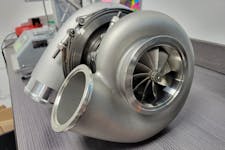Although the capabilities of 3D printing technology have begun to expand exponentially (remember the excitement just a few short years ago when 3D printers first began to spit out rudimentary plastic figurines?), even we weren’t ready for a printed product that can belch flame and roar like a jet fighter. But that’s exactly what the engineers at GE demonstrate in this video.
 The technology behind 3D printing has allowed the process to evolve into servicing many different industries; the engineering and development potential is off the charts, as evidenced by the engine seen here. Turning imagination into reality at a much faster pace than ever thought possible previously is a hallmark of the 3D printing process. GE’s engineers have taken concepts out of the development stages and turned them into real-life, this-is-happening-now reality.
The technology behind 3D printing has allowed the process to evolve into servicing many different industries; the engineering and development potential is off the charts, as evidenced by the engine seen here. Turning imagination into reality at a much faster pace than ever thought possible previously is a hallmark of the 3D printing process. GE’s engineers have taken concepts out of the development stages and turned them into real-life, this-is-happening-now reality.
Using a technology known as DMLM (direct metal laser melting, a GE version of direct metal laser sintering (DMLS), in which powdered metal is heated with lasers guided by a 3D printing program and then layered until the product is finished), GE managed to create this fully functional jet engine for a radio-controlled plane.
DMLS was developed by the German firm EOS, and this engine was created in an EOS M270 printer. Besides demonstrating that complex, close-tolerance parts (i.e., jet-engine components) are perfect candidates for CAD-assisted 3D printing, this test-firing–in which the engine was brought up to 33,000 RPMs–also shows the levels of durability that can be achieved. Who doesn’t love the sound of a turbine at full song? Stand back–and enjoy!
You might also like
Composite Dreams: Making the Case for Carbon Fiber Connecting Rods
Forged carbon fiber connecting rods may be the next evolution in engine parts. Where steel is traditionally used, carbon fiber can offer advantages in both strength and weight.






